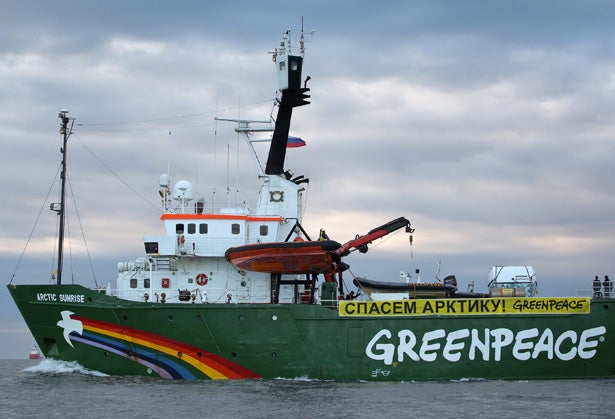Heading out the door? Read this article on the new Outside+ app available now on iOS devices for members! Download the app.
Photo: Greenpeace/Denis Sinyakov

When you think piracy, Greenpeace doesn’t immediately come to mind. Yet that was the charge, along with “hooliganism,” leveled against 30 of the environmental non-profit’s activists in 2013 by the Russian government—after Russian special forces seized the team from the Greenpeace ship Arctic Sunrise during its protest at the site of the first-ever oil drilling operation in Arctic waters. Skillfully capturing the suspense of the event, the film Black Ice documents the ordeal of what’s come to be known as the Arctic 30. When asked about the current status of the Russian energy company Gazprom’s oil-drilling rig in the Arctic, Greenpeace International Head of Arctic Oil Campaign Ben Ayliffe says: “The rusting platform continues to pose a threat to the Arctic environment in the Pechora Sea on a daily basis. It remains a question of when an accident will happen there rather than if.” Here, Ayliffe responds to additional questions.
What’s the evidence that, as Greenpeace campaigner Dima Litvinov says in the film, the incident involving him and his fellow activists helped raise public awareness of the problem of the melting Arctic?
The fate of the Arctic 30 captivated millions of people. Tens of thousands took to the streets of cities the world over to call for their release, whilst over a million new people joined the Greenpeace Save the Arctic campaign as a result of seeing the fate that Dima and his colleagues faced once our ship was illegally seized in the Russian Arctic. The reckless charge into the icy far north that oil companies like Gazprom are now involved in became front-page news from Mumbai to Minneapolis, and a powerful spotlight was shone on the creeping industrialization of this unique and fragile region, which otherwise may have gone unnoticed. Greenpeace are now building on the exposure the story of the Arctic 30 gave to this special place to ensure that their struggles, and the efforts of ordinary people around the world, result in the sort of lasting protection the Arctic urgently requires.
How would you gauge the threats to wildlife from Arctic drilling?
The prospect of an Arctic oil spill would be a nightmare scenario for this remote and fragile area. There is simply no way to clean up oil spilled in ice, and an accident here would have a devastating impact on what is a delicate and little-understood ecosystem. The Arctic is home to unique animal species like narwhal, polar bears, and walrus: all of these would directly impacted by a spill that we simply wouldn’t be able to clean up.
How has the current drop in oil prices affected the push toward offshore drilling in the Arctic?
The current fall in oil prices has certainly started to make more people, including investors, question the sense of such expensive and risky projects as Arctic oil. In Gazprom’s case, this is compounded by the low-grade oil produced by Prirazlomnaya [the company’s oil platform in the Arctic], as there’s currently a glut of that around. Why spend such huge amounts for a product that’s available elsewhere? It makes very little sense. However, it’s worth considering that oil prices are volatile. We don’t know what a barrel of crude will cost next week, let alone next year, so the price at the pumps today isn’t perhaps the most significant factor the likes of Gazprom or Shell will consider when deciding to go farther into the Arctic, as such projects won’t be commercially viable—even if they manage to find oil, a big if—for decades.
Has there been any progress—as advocated in the film and patterned after the agreement over the Antarctic—toward declaring the Arctic a global sanctuary, free of economic and military development?
We’re making real progress toward an Arctic Sanctuary. Finland has already backed its creation, as have the European Parliament, whilst senior politicians from places as far apart as Kiribati and Germany want to see it happen too. Additionally, over 6 million people have signed up to our campaign to Save the Arctic. A movement has been born, and we won’t stop until the top of the world is protected for everyone.